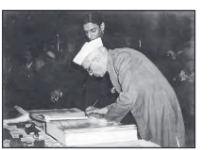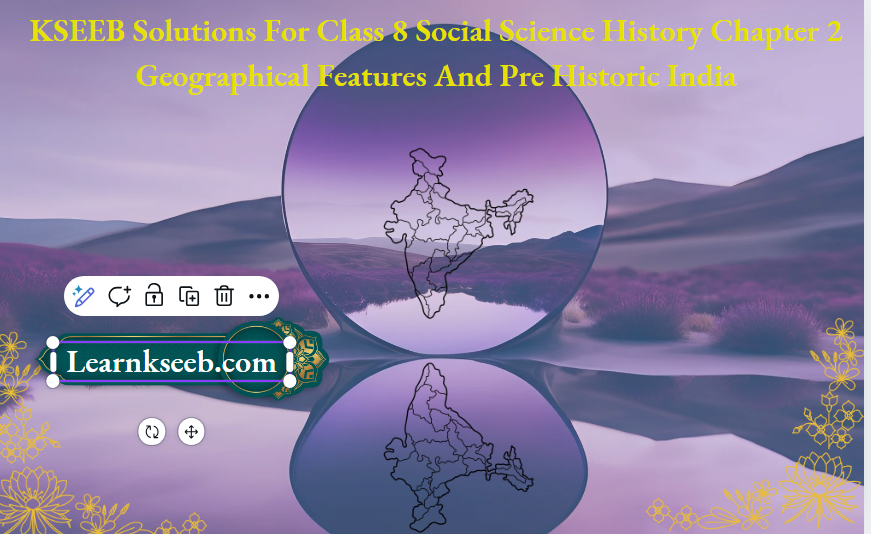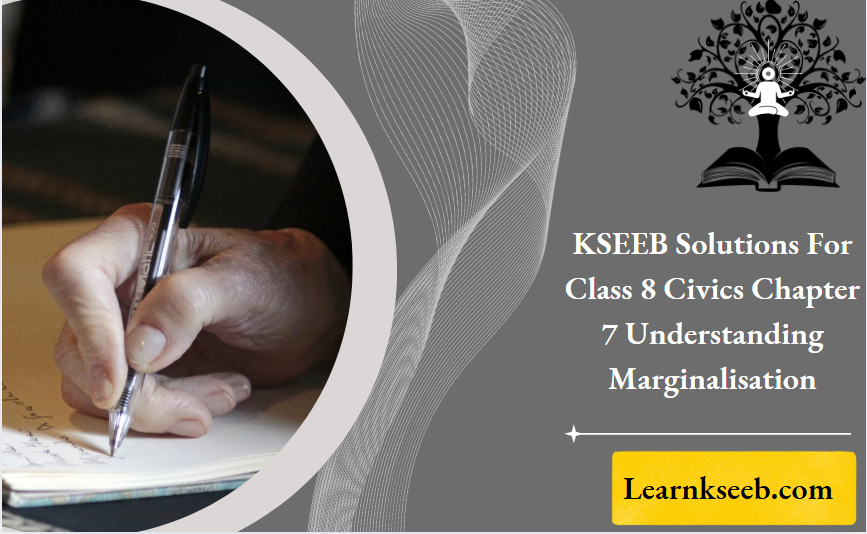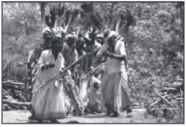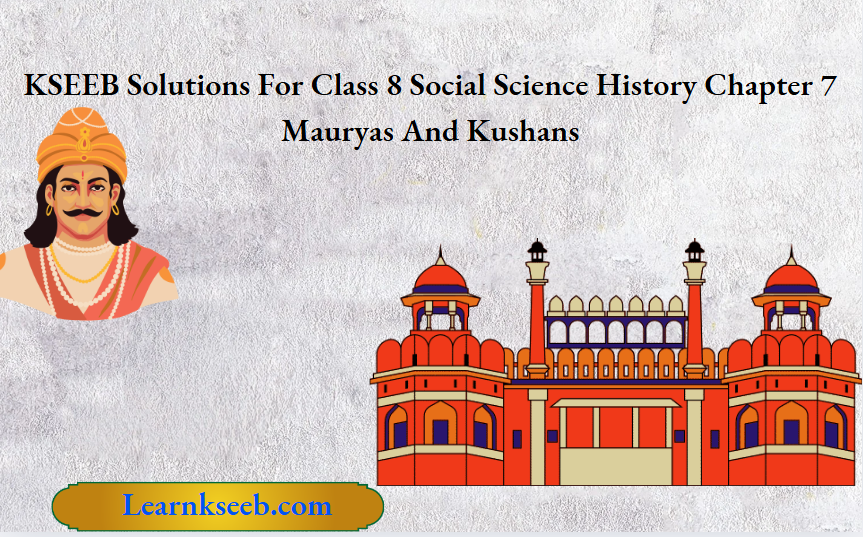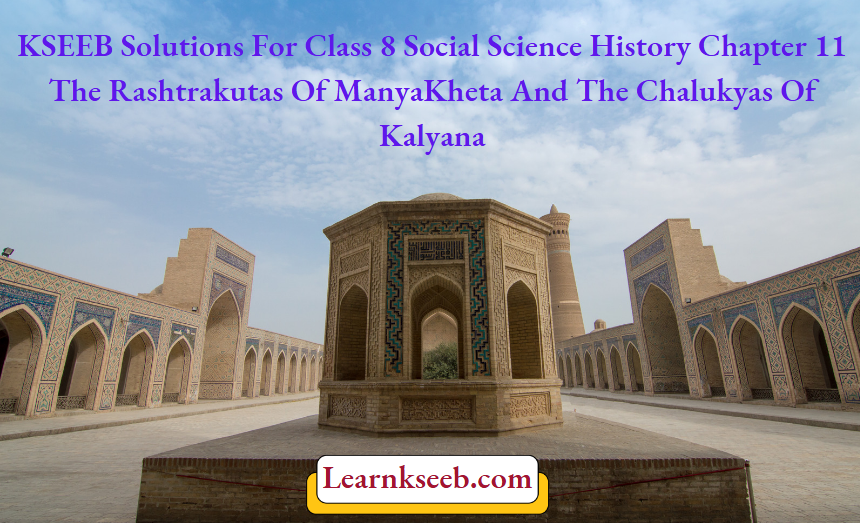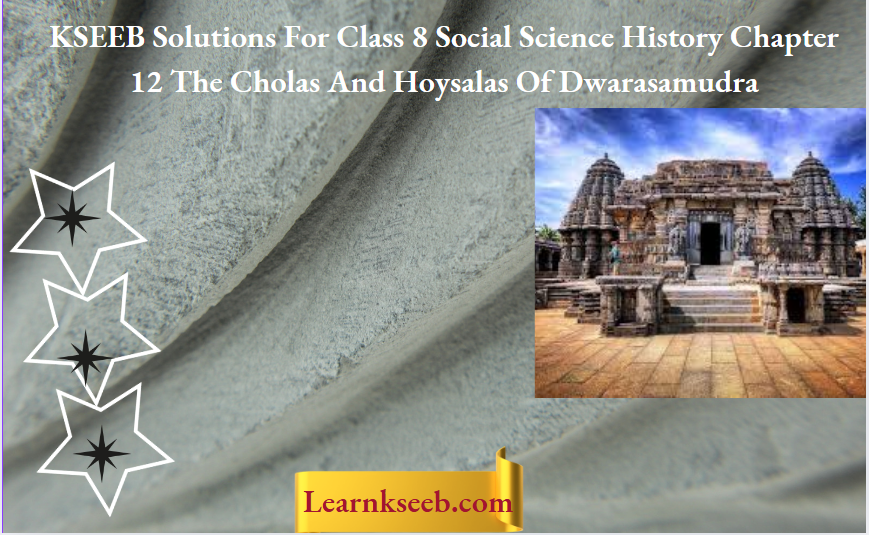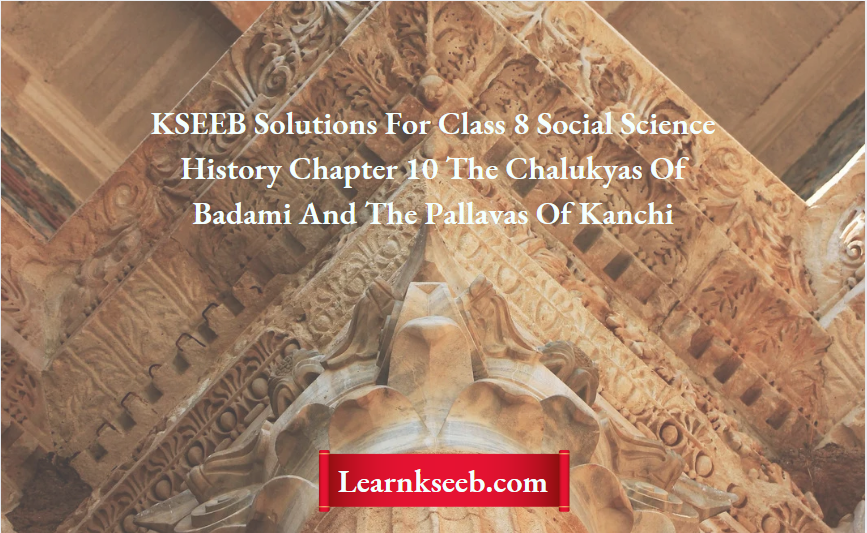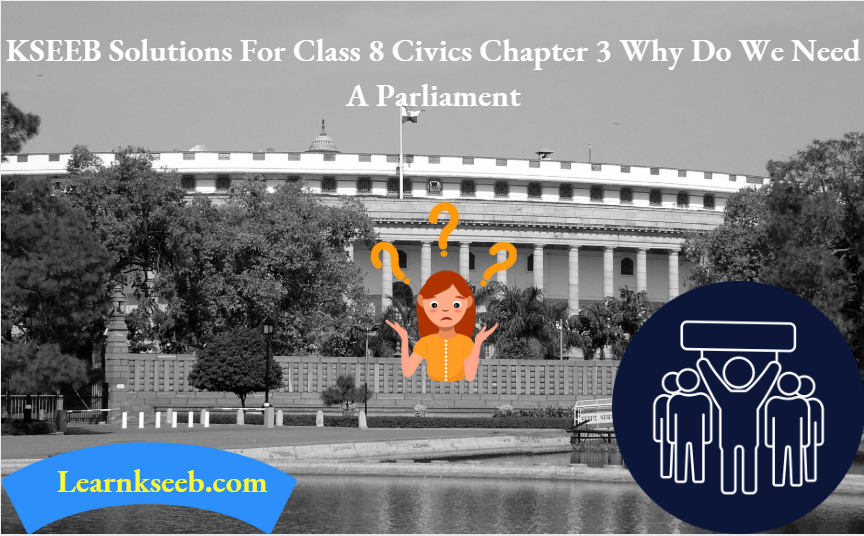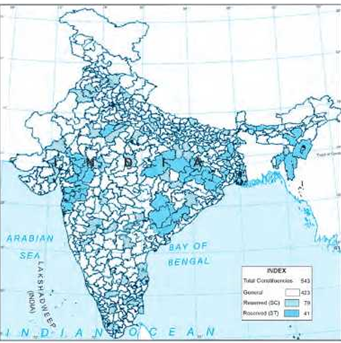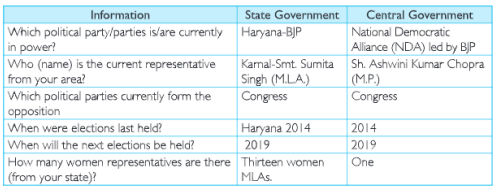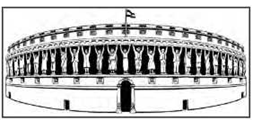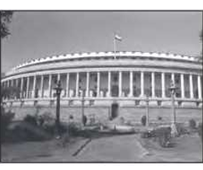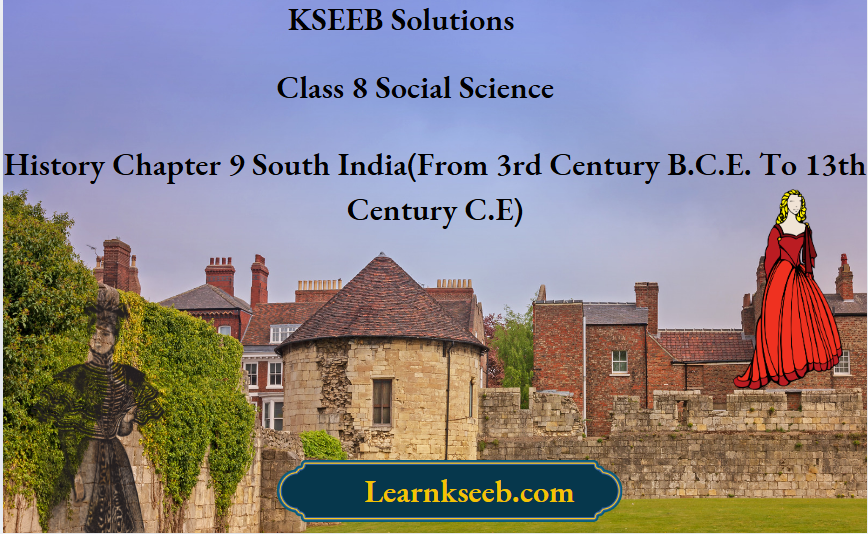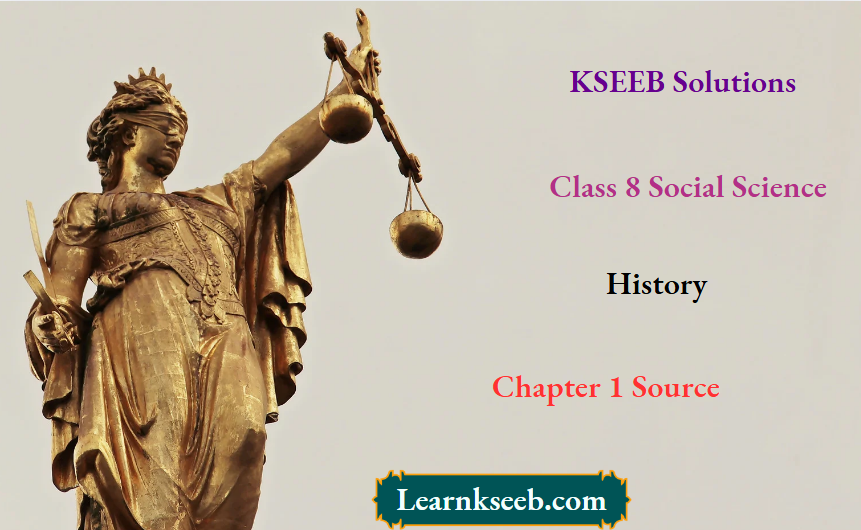KSEEB Solutions Class 8 Civics Chapter 1 The Indian Constitution Textbook Questions
Question 1. Why does a democratic country need a Constitution?
Answer. All the democratic countries of the world have a Constitution. A democratic country needs Constitution due to the following reasons:
- Supreme Law of the Country: The Constitution is the supreme law of the state. The government at the state and central level work within the sphere of powers given to them by the constitution.
- Provide Basic Rules: The Constitution provides basic rules and principles on the basis of which a democratic government functions.
- Nature of Government: It is the Constitute on that decides how the government will be organised.
- Rule of Law: Rule of law is a basic feature of a democratic country and the Constitution makes provisions for this feature.
- Limitations on the Government: The Constitution imposes limitations on the three organs of the government.
Question 2. Look at the wording of the two documents given below. The first column is from the 1990Nepal Constitution. The second column is from the more recent Interim Constitution of Nepal.

What is the difference in who exercises ‘Executive Power’ in the above two Constitutions of Nepal? Keeping this in mind, why do you think Nepal needs a new Constitution today?
Answer . Under Article 35 of 1990, in the Constitution of Nepal, executive powers were exclusively vested with the King of Nepal. The King was the head of the state, as well as head of the government
He exercised all the executive powers which were absolute. But under the Interim Constitution of 2007, the executive powers are vested with the Council of Ministers. The executive powers and functions are exercise in the name of the Prime Minister of Nepal.
Council of Ministers and Prime Minister exercise executive powers in accordance with the provisions of the Constitution. According to the Interim Constitution, Constitution is supreme rather than the King of Nepal. In changed circumstances, there is a great need of a new’ Constitution which is based on democratic principles. Old Constitution does not reflect the ideals of the country. Hence, a new Constitution is needed for establishing democracy in Nepal.
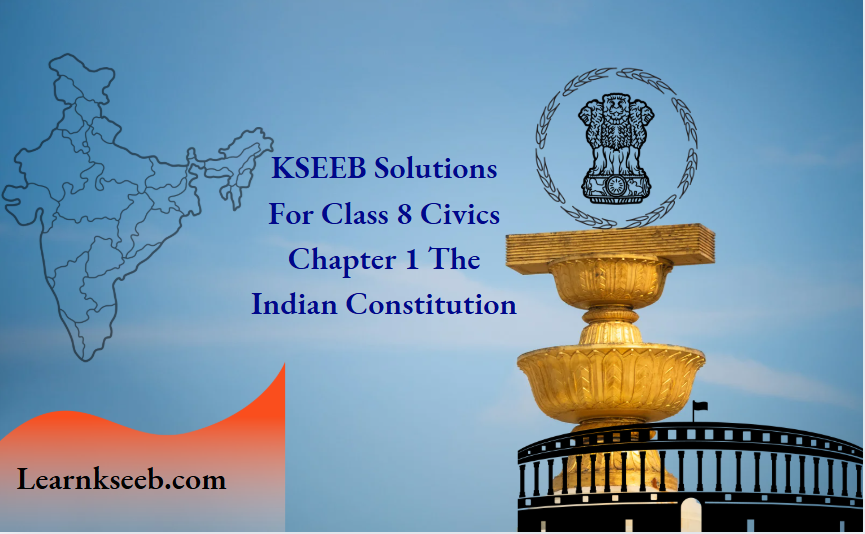
Question 3. What would happen if there were no restrictions on the powers of elected representatives?
Answer. In a democratic country, the government is run by the elected representatives. In India, legislative and executive powers are vested with the elected representative of the people. It is very essential that the elected representatives exercise their power to serve the people. They should exercise their powers in accordance with the provision of the Constitution. There should be some constitutional and legal restrictions on the powers of the elected representatives.
If there are no restrictions, then the elected representatives will misuse the powers for their selfish interests and they will not serve the people. The Constitution limits the powers of the elected representatives in many ways. Generally, the powers of the elected representatives are limited by giving fundamental rights to the citizens.
Question 4. In each of the following situations, identify the minority. Write one reason why you think it is important to respect the views of the minority in each of these situations.
(a)In a school with 30 teachers, 20 of them are male.
(b)In a city, 5 per cent of the population are Buddhists.
(c)In a factory mess for all employees, 80 per cent are vegetarians.
(d)In a class of 50 students, 40 belong to more well-off families.
Answer.
(a) In a school with 30 teachers, women teachers are in a minority. Male teachers should respect the views and wishes of women teachers because under the Constitution, both men and women are equal.
(b)In a city, Buddhists are in a minority and the majority should respect the religion and sentiments of the Buddhists.
(c)In a factory mess, non-vegetarians are in a minority and majority vegetarians should respect the views of the minority
.
(d)In a class of 50 students, 10 students who are rot from well-off families are in a minority. The majority should respect the views of the minority so that inferiority complex does rot develop among them.
Class 8 Civics The Indian Constitution KSEEB Notes
Question 5. The column on the left lists some of the key features of the Indian Constitution. In the other column write two sentences, in your own words, on why you think this feature is important:


Questions 6. Color the following countries on the given map:
(a)Color India in red
(b) Color Nepal in green
(c) Color Bangladesh in yellow
Answer. Color it yourself.
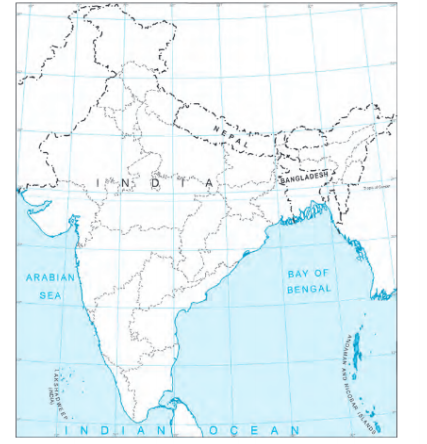
The Indian Constitution Text Questions
Question 1. Discuss with your teacher what you understand by the term ‘constitutive’. Provide one example of constitutive rules’ from your everyday life. Why do the people of Nepal want a new Constitution?
Answer. The people of Nepal want a new constitution because the old constitution does not reflect the ideals of the country. The people of Nepal want Nepal to be an ideal country for which they have fought for.
Question 2. Look at the pictures given on Page 7 of the NCERT Textbook and answer the following questions:
(i)In what way is the class monitor misusing his power?
(ii)In which of the following situations is a minister misusing his power:
(a)refuses to sanction a project of his ministry for sound technical reasons;
(b)threatens to send his security staff to rough up his neighbor;
(c)calls up the police station asking them not to register a complaint that is likely to be filed against his relative.
Answer.
(i)The monitor, Suresh, is misusing his power by picking on Anil.
(ii)(a)The minister s not misusing his powers.
(b)The minister is misusing his powers.
(c)The minister is misusing his powers.
Question 3. Who is in a minority in the storyboard on In what way is this minority being dominated by the decision taken by the majority?
Answer. The girls are the minority in the storyboard. The girls are being dominated by the boys as the teacher decides what game they should play by the show of hands and as there are more boys in the class, the boys always dominate the girls.
Question 4. Why was Shabnam happy chat she had not watched TV? What would you have done in a similar situation?
Answer. Shabnam was happy by not watching the TV. because she revised the chapters and there were many questions from the last two chapters. I would have done the same.
Question 5. Discuss the difference between State and Government with your teacher.
Answer. The word ‘State’ does not refer to state governments and is used to distinguish it from ‘government1. The Government can change with every election and is responsible for enforcing the laws and administering them. On the contrary, a State is a political institution representing the sovereign people within a particular territory. The government (or the executive) is one part of the State. The Government and the State are two very- different concepts and can not be used in place of the other.
questions 6. Which Fundamental Rights will the following situations violate:
- If a 13-year old child is working in a factory manufacturing carpets.
- If a politician in one state decides to not allow laborers from other states to work in his state.
- If a group of people are not given permission to open a Telugu-medium school in Kerala.
- If the government decides not to promote an officer of the armed forces because she is a woman.
Answer.
- Right against Exploitation
- Right to Freedom
- Cultural and Educational Rights
- Right to Equality.
KSEEB Class 8 Civics Chapter 1 Questions And Answers
Question 7. The Constitution also mentions fundamental duties. Find out with the help of your teacher what these include and why it is important for citizens in a democracy to observe these.
Answer . It is important for citizens in a democracy to observe these Fundamental Duties as they tell us:
1.To abide by the Constitution and respect its ideals and institutions, the National Flag and the National Anthem.
2.To cherish and follow the noble ideals which inspired our national struggle for freedom.
3.To uphold and protect the sovereignty, unity and integrity of India.
4. To defend the country and render national service when called upon to do so.
5. To promote harmony and the spirit of common brotherhood amongst all the people of India transcending religious, linguistic and regional or sectional diversities, to renounce practices derogatory to the dignity of women.
6. To value and preserve the rich heritage of our complete culture.
7. To protect and improve the natural environment including forests, lakes, rivers and wildlife, and to have compassion for living creatures.
8. To develop the scientific temper’, humanism and the spirit of inquiry and reform.
9. To safeguard public property and to abjure violence.
10. To strive towards excellence in all spheres of individuals and collective activity’ so that the nation constantly rises to higher levels of endeavor and achievement.
II. Who is parent or guardian to provide opportunities for education to his child or as the case may be ward between the age for 6 to 14 years.
The Indian Constitution Very Short Answer Type Questions
Question 1. Who was the Chairman of the Drafting Committee?
Answer. Dr. B.R. Ambedkar was the Chairman of the Drafting Committee.
Question 2. When was the Constituent Assembly of India established?
Answer. The Constituent Assembly was established in July, 1946.
Question 3. How much time did the Constituent Assembly take to draft the Indian Constitution?
Answer. The Constituent Assembly took 2 years, I I months and 18 days to frame the Constitution.
Question 4. Name the permanent Chairman of the Constituent Assembly.
Answer. Dr. Rajendra Prasad was the Permanent Chairman of the Constituent Assembly.
Question 5. What is the source of the authority according to the Preamble?
Answer. The Preamble expresses in a very clear language that the people are the ultimate source of all authority.
Question 6. How many members were there in the Constituent Assembly?
Answer . The Constituent Assembly consisted of 389 members.
Question 7. What form of government exists in India?
Answer. The Indian Constitution establishes a parliamentary form of government in India.
Question 8. State any two features of the Constitution of India.
Answer.
- The Constitution of India is in a written form and is supreme.
- The Constitution of India is the most detailed Constitution in the world.
Question 9. Explain the meaning of Fundamental Rights.
Answer. The legal rights mentioned in the Constitution are called Fundamental Rights. These rights are considered essential for the development of an individual.
Question 10. How many Fundamental Rights are there ‘at present’ in our Constitution?
Answer. At present, there are six Fundamental Rights n our Constitution.
Question 11 . Mention one characteristic of the Right against Exploitation.
Answer. Selling and buying (trafficking) of human beings and forced labor is prohibited.
Question 12. Mention one distinction between the Fundamental Rights and Directive Principles of State Policy.
Answer. Fundamental Rights are justifiable while Directive Principles are not.
Question l3. Which type of government existed in Nepal in 1990?
Answer. In 1990, Nepal had monarchy.
Question 14. When was democracy established in Nepal?
Answer. In 2006, democracy was established in Nepal.
Question 15. Why did the people of Nepal want a new constitution?
Answer. The people of Nepal wanted a new constitution as the old constitution did not reflect the ideals of the country, that the people of the country want Nepal to be, and that they had fought for.
The Indian Constitution KSEEB Class 8 Textbook Solutions
The Indian Constitution Short Answer Type Questions
Question 1. Explain the meaning of Constitution.
Answer. The Constitution is a collection of those rules and regulations according to which the administration of the state is run. The administration of each state is run in accordance with certain rules law regulations. It is the fundamental law reflecting the will of the people. It determines the powers and responsibilities of the state. It also states people’s rights and duties.
Question 2. Write a short note on the meaning of the Preamble.
Answer. The Constitution of India begins with a Preamble. The Preamble serves the purpose of a window through which we peep into the intentions of the makers of the Constitution. In short, the Preamble is a summary of the objectives and basic philosophy of the Constitution. It helps n the interpretation of the constitution. With the help of the Preamble, we can understand the basic philosophy of the Constitution.
Question 3. Discuss the objectives of our Constitution as embodied in the Preamble.
Answer. Following are the objectives of our Constitution given in the Preamble:
- Justice—social, political and economic;
- Liberty of thought, expression, belief, faith and worship;
- Equality of status and opportunity, and
- Fraternity, assuring the dignity of the individal and the unity of the Nation.
Question 4. Mention some federal features of our Constitution.
Answer.
- It is a written Constitution.
- It is partly rigid.
- There is a distribution of powers between the centre and the states.
- There is an independent and competent Supreme Court to settle disputes between the Centre and the States and among the States.
- Union Parliament is bicameral. It consists of two Houses—the Lok Sabha and the Rajya Sabha.
- The Constitution is supreme.
Question 5. Mention four features of the Indian Parliamentary System.
Answer.
- The President of India is a nominal head of the State.
- The Cabinet, with the Prime Minister as its head, act as the real executive.
- There is a close relationship between the Cabinet and the Parliament.
- The Cabinet is collectively responsible to the Parliament.
Question6. Why are Fundamental Rights enumerated in the Indian Constitution?
Answer. Fundamental Rights are included in the Constitution to uphold the dignity of the individual. The object of Fundamental Rights is to sustain the proposition that the system of government by the Constitution embodies the concept of limited government, i.e., a government of laws and not of men.
Question 7. Mention any two Fundamental Rights which Constitution confers on minorities.
Answer.
- The Constitution provides that any section of the citizens residing in the territory of India or any part thereof having distinct language, script or culture of its own shall have
- The Constitution provides that all minorities, whether based on religion or language shall have the right to establish and administer educational institutions of their choice. The State shall not in granting aid to educational institutions, discriminate against any educational institution on the ground that it is under the management of a minority
Question 8.Mention any two conditions under which ‘Fundamental Rights’ can be restricted.
Answer.
- During the proclamation of emergency caused by external aggression or armed rebellion, the President can by order suspend Fundamental Rights and their enforcement in the court of law.
- During emergency caused by internal disturbance, Fundamental Rights under Article 19 are automatically suspended in the disturbed area.
Question 9. Explain the meaning of Directive Principles of State Policy.
Answer. The Directive Principles of State Policy are those principles which are fundamental in the governance of the country. These principles describe the ambitions and aspirations of the framers of the Constitution regarding the establishment of welfare state in India. The Directive Prince pies are in the nature of directions, instructions or recommendations to the Union and State government to be followed while framing the laws and formulating the policy.
Question 10. Write any four Directive Principles of State Policy.
Answer.
- The state shall strive to promote the welfare of the people.
- The state shall strive to minimise the inequalities in status, facilities and opportunities.
- A uniform civil code throughout the territory of India.
- The state shall promote international peace and security.
Question 1l . Explain briefly the purposes of the Constitution.
Answer.
- The Constitution lays out certain ideals and objectives which the country should follow.
- The second purpose of a Constitution is to define the nature of a country’s political systems.
- The Constitution puts limitation or the elected representatives of the people so that they cannot misuse the powers.
Important Questions For KSEEB Class 8 Civics Chapter 1
The Indian Constitution Long Answer Type Questions
Question 1. ‘India is a Sovereign, Socialist, Secular, Democratic, Republic. Explain.
Answer. The Preamble proclaims that the people of India have resolved to constitute India into a Sovereign, Socialist, Secular, Democratic, Republic.’
- India is a Sovereign State: It means that now, after the promulgation of the Constitution, India is not subject to any foreign rule. India is fully sovereign, internally as well as externally. No other country can compel India to follow or not to follow a particular policy.
- India is a Socialist State: Natural resources and wealth of the nation should be used for the welfare of the whole society. Government should regulate the ownership of land and industry to reduce socio-economic inequalities.
- India is a Secular State: There is no offical religion of the state. Freedom of religion has been granted to all persons residing in India. All persons are equally entitled to freedom of conscience and the right to practice and propagate religion.
- India is a Democratic State: Indian policy is based on democratic principles. The people elect their representatives on the basis of adult franchise. Al citizens enjoy equal political rights. The government is run according to same basic rules.
- India is a Republican State: The head of the state (President) is elected for a period of five years. There is no room for a hereditary monarch like the one in England.
Question 2. Discuss basic features of the Indian Constitution,
Answer . Important features of the Constitution are the following:
- A Written and Detailed Constitution: The Republic of India has a written Constitution. It is the longest and the most detailed Constitution n the world. It is five times as long as that of the U.SA
- Federal Structure: The Indian Constitution is Federal in structure. It has federal features such as a written Constitution, division of subjects between the center and the states, double sete of governments independent judiciary, bicameral legislature, etc. Though the Constitution is federal in structure, it is unitary- in spirit It has some unitary- features like the distribution of powers in favor of the Centre, financial dependence of the states on the Centre and Emergency powers of the centre. Al these provisions make the union government very’ strong.
- Parliamentary Form of government India has a Parliamentary form of government like Great Britain. The executive head of the state, i.e., the President is the nominal head. The real powers of the state are enjoyed by the Prime Minister and the Cabinet The Cabinet is responsible to the Parliament. It can compel the cabinet to resign by passing a vote of no confidence against it
- Fundamental Rights and Duties: Fundamental Rights of citizens are provided in the Constitution, if a citizen’s right is infringed, he can go to the court for the protection of his right. The citizens : are also required to perform certain duties. These are essential for their own development and
to uphold the sovereignty, unity and integrity of the country. - Directive Principles of State Policy: These are the guiding and directive principles which the government makes keep in mind while framing its policies. These principles are for the welfare • of the people and aim at establishing a socialist society’.
- Single Citizenship: The Indian citizens are granted single citizenship that of the Indian union alone. This means that all citizens are regarded as the citizens of India. They do not hold the separate citizenship of the state in which they live.
- Independent Judiciary: The Constitution makes the judiciary independent. An independent judiciary can safeguard the rights and liberties of the citizens. It protects the individual against the high-handedness of the government.
- Universal Adult Franchise: To make India a truly democratic state, every1 adult has been given the right to vote. Every citizen above the age of eighteen, has the right to vote without any discrimination. There are more than seventy crore voters who can vote in general elections.
- Our National Language: The Constitution recognises Hindi as the official language of India.
- Secular State: The Constitution of India establishes a secular state. The citizens have been guaranteed freedom of religion. There is no official religion of the state.
Question 3. Examine the significance of the Preamble to the Indian Constitution.
Answer . The Preamble is not a part of the Constitution. It does not have any legal force. Still it has special significance. The significance of the Preamble s as follows:
- Source of Authority: The Preamble defines the source of authority from the Constitution is derived. The words, ‘We, the people of India are very significant.
- Nature of Indian Polity: The Preamble emphasises the fact that India is a Sovereign, Socialist, Secular, Democratic, Republic.
- Symbol of Objectives: The Preamble is the symbol of those objectives which the Constitution makers pledged to attain. The Preamble assures the people of India Justice-modal, Economic and Political.
- Key to the Constitution: The Preamble is the soul and spirit of the Constitution. The Preamble is the mirror of the Constitution.
- Guide to the Government: The Preamble to the Constitution provides guidelines to the government of the day
- .Guidelines to the Judiciary: Whenever a Court of Justice has to explain some articles of the Constitution then it takes the help of the ideas expressed through the Preamble of the Constitution.
- Yardstick to Evaluate the Performance of the Government The Preamble enables the people to assess and evaluate the performance of the government in the light of the objectives laid down in the Preamble. It keeps the government on its toes.
Question 4. Discuss the objectives of the Constitution mentioned in the Preamble.
Answer. In the Preamble following objectives are mentioned:
- Justice: The object of the Constitution is that all the citizens of India should get justice in every sphere of life. In the Preamble, the idea of achieving social, economic and political justice for all citizens has been mentioned. To achieve social, economic and political justice provisions have been made in the Constitution.
- Liberty: Another objective of the Indian Constitution is to secure liberty for the people of India. The citizens of India have been guaranteed a number of freedoms by the Constitution. The Preamble holds forth an assurance to secure to all citizens liberty of thought, expression, belief, faith and worship and equality of status and opportunity.
- Equality: The third objective of the Indian Constitution laid down in the Preamble is equality. The Preamble ensures equality of aJI in the eyes of law. No person is to be deprived of his life and liberty unless he has violated a law in existence. Whatever may be the social status of a person, he is a subject to law. The Constitution prohibits discrimination on the basis of caste, color, creed, religion, sex, place of birth, etc. The Constitution provides equality of opportunity to all.
- Fraternity: The Preamble to the Constitution lays special stress upon the promotion of fellow feeling among the people of India. Unless the people become a community of interests, their cohesion into one nation is not possible. No one should treat a fellow citizen as inferior.
- Integrity: The inclusion of the term integrity expresses ‘our determination to put an end to all separatist tendencies.’
Question 5. Describe the various Fundamental Duties which are laid down In Indian Constitution.
Answer . Following are the various Fundamental duties, which are laid down in Indian Constitution:
- To abide by the Constitution and respect its ideals and institutions, the National Flag and the National Anthem.
- To cherish and follow the noble ideals which inspired our national struggle for freedom.
- To uphold and protect the sovereignty, unity and integrity of India.
- To defend the country and render national service when called upon to do so.
- o promote harmony and the spirit of common brotherhood amongst all the people of India transcending religious, linguistic and regional or sectional diversities, to renounce practices derogatory to the dignity of women.
- To value and preserve the rich heritage of our complete culture.
- To protect and improve the natural environment including forests, lakes, rivers and wildlife, and to have compassion for living creatures.
- To develop the scientific temper, humanism and the spirit of inquiry and reform.
- To safeguard public property and to abjure violence.
- To strife to wards excellence in all spheres of individuals and collective activity so that the nation constantly rises to higher levels of endeavor and achievement.
- Who is parent or guardian to provide opportunities for education to his child or as the case may be ward between the age for 6 to 14 years.
Class 8 Civics Chapter 1 The Indian Constitution Guide KSEEB
Question 6. Write an essay on ‘Fundamental Rights’ as incorporated in our Constitution.
Answer. The fundamental Rights enumerated in the Indian Constitution are the most elaborate in the world. The Constitution of India provides for Fundamental Rights by developing a complete and separate Part {Part III) and classifies them under six categories. Six fundamental rights can be explained as follows:
- Right of Equality (Articles 14 to 18): The Constitution declares all the citizens of India to be equal in the eyes of law. Law provides equal protection to all. The concept of equality is that special privileges of all kinds should be abolished. Untouchability is abolished.
- Right to Freedom (Articles 19 to 22): The Constitution guarantees to the citizens Rights of Freedom. Article 29 guarantees six freedoms viz. (a) Right to Freedom of Speech and Expression; (b) Right to assemble peacefully and without arms; (c) Right to form associations; (d) Right to move freely throughout the territory of India; (e) Right to reside and settle in any part of the territory of India; (f) Right to practise any profession. Articles 20 to 22 guarantee personal liberty.
- Right against Exploitation (Articles 23-24): The Constitution of India recognises the dignity of the individual and protect him against any form of exploitation either by the State or by the privileged classes in the society. Art. 23 provides that traffic in human beings and beggar (forced labor) and similar other forms of forced labor are prohibited. Art. 24 prohibits the employment of children below the age of 14 in any factory, mine or any other hazardous (dangerous) employment.
- Right to Freedom of Religion (Articles 25-28): Right to freedom of religion has been guaranteed to all persons residing in India. The Constitution provides that subject to public order, morality and health, all persons are equally entitled to freedom of conscience and the right to profess, practise and propagate religion. The Constitution prohibits imparting of religious instructions in any educational institution wholly maintained out of State funds.
- Cultural and Educational Rights (Articles 29 and 30): The Constitution guarantees certain cultural and educational rights. No citizen shall be denied admission into any educationaJ institution maintained by the State receiving aid out of State funds on grounds of religion, race, caste, language or any of them.
The Constitution protects the interests of the minorities in India. The Constitution provides that all minorities, whether based on religion or language, shall have the right to establish and administer educational institutions of their choice. - Right to Constitutional Remedies (Article 32): The Constitution guarantees the right to move the Supreme Court by appropriate proceedings for the enforcement of the rights conferred by Part III of the Constitution.
Question 7. Write the distribution of powers in Indian Federalism.
Answer. The Constitution of India very clearly distributes the power between the centre and the states. There are three lists of powers between the centre and the states, given in the Constitution:
- The Union List: There are 97 subjects n the Union list. Only the union government can make laws on these subjects. The main subjects are – Railways, Post and Telegraph, Coinage and Currency, Defence and Foreign Affairs. Laws framed on these subjects are enforced in all states and on all citizens equally.
- The State List: There are 66 subjects in teh s list. The state government can make laws on them. The main subjects are-law and order, police, agriculture, irrigation and public works. The state legislature frames laws on these subjects.
- The Concurrent List: There are 47 subjects in the concurrent list On these subjects both the Centre and the States can make laws. But if the two laws are contradictory, the laws made by the Centre shall prevail. The Residuary powers have been given to the Centre under the Constitution.
Question 8. Mention main Federal features of Indian Constitution.
Answer. Following are the main features of Indian Federation:
- Division of Powers: The Constitution distributes powers between the union government and state government There are three lists or powers in the Constitution: (a) Union List; (b) State List; and (c) Concurrent List
- Written Constitution: Indian Constitution is a written document. The Indian Constitution consists of 448 Articles and 12 Schedules and so far over 100 Amendments have been made in the Constitution.
- Rigid Constitution: The Constitution of India is also a rigid one.
(iv)Supremacy of the Constitution: Indian Constitution is Supreme. The CentraJ and the state governments in India have to act in accordance with the Constitution. The power of judicial review is given to the Supreme Court and high courts to maintain the supremacy of the constitution. - Supremacy of Judiciary: The Indian Constitution establishes a powerful and independent judiciary’ in India. It decides disputes between the Centre and the State. It interprets the Constitution and its interpretations are final.
- Bicameral Legislature: The Indian Parliament consists of two Houses—Lok Sabha and Rajya Sabha. The Lok Sabha is the lower house whereas Rajya Sabha is the upper house. Lok Sabha is more powerful than Rajya Sabha.
The Indian Constitution Hots Corner
Question 1. State the necessity of a Preamble in a Constitution.
Answer. It is considered essential that ever)’ written Constitution should possess a Preamble. The Preamble contains the basic ideals and philosophical postulates of a Constitution. The Preamble to the Constitution mirrors the spirit of Constitution. The Indian Constitution also begins with a Preamble. The preamble is essential because it serves the purpose of a window through which we peep into the intensions of the makers of the Constitution. It enables the people to assess and evaluate the performance of the government in the light of the objectives laid down in the Preamble.
Question 2. The Indian Constitution is called a living document’. How?
Answer. Indian Constitution is dynamic. It can be amended to suit the changing condations of the country; After the enforcement of the Constitution, many great social, economic and political changes have come in India. As a result, quite often the need arises to make changes in the Constitution to make it suitable for the new conditions in India. So, the provisions have been made in the Constitution for its amendment from time to time. Till 2015, 100 amendments have been made.
KSEEB Civics Chapter 1 Class 8 The Indian Constitution Miscellaneous Questions
A. Multiple Choice Questions
Tick the correct option from the choices provided:
Question 1. Indian Constitution was framed by:
(a) Indian Parliament
(b) Dr. Ambedkar
(c) Constituent Assembly
(d) British Parliament
Answers. (c) Constituent Assembly
Question 2. The Indian Constitution was enforced on:
(a)9th December, 1950
(b)15th August, 1947
(c)2oth November, 1949
(d)26th January, 1950
Answer. (d)26th January, 1950
Question 3. Aims of the Constitution are mentioned in the:
(a)Preamble
(b)Fundamental Rights
(c)Directive Principles
d)None of these
Answer. (a) Preamble
Question 4. Who was the Chairman of the Drafting Committee of the Constituent Assembly?
(a)Dr. Ambedkar
(b)Pt Jawahar Lai Nehru
(c)Dr. Rajinder Prasad
(d)K.M. Munshi
Answer. (a) Dr. Ambedkar
Question 5. Which of the following right is available under the Indian Constitution?
(a)Right to Equality
(b)Right to Freedom
(c)Right against Exploitation
(d)All of these
Answer.(d) All of these
Question 6. At present Indian citizen enjoys:
(a)Seven Fundamental Rights
(b)Eight Fundamental Rights
(c)Six Fundamental Rights
(d)None of these
Answer. (c) Six Fundamental Rights
The Indian Constitution B. One Word Sentence Answers
Answer the following questions in one word/sentence:
1. The Indian Constitution begins with this document.
Answer. Preamble.
2. An assembly of people’s representatives who framed the Constitution for a country.
Answer. Constituent Assembly.
3. The permanent Chairman of the Constituent Assembly.
Answer. Dr. Rajendra Prasad.
4. A type of government which existed in Nepal in 1990.
Answer. Monarchy.
5. The number of Fundamental Rights that are present in our Constitution.
Answer. 6.
The Indian Constitution C. Match The Following
Find and write the correct options from the given below columns:

Answer. 1. (e) 2. (b) 3. (a) 4. (c) 5. (d)
The Indian Constitution D. Picture Interpretation
Look at the following picture and answer the questions that follow:
- who is the personality shown?
- What document is he signing?
- What is the importance of this document?
Answer.
- The personality shown in the picture is Jawaharlal Nehru.
- He is signing the Constitution of India.
- This documents holds immense importance as it is needed to run the country efficiently.
